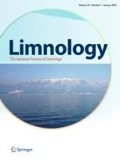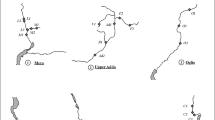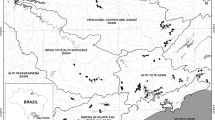Abstract
Diatom indices developed in certain geographic regions are frequently used elsewhere, despite the strong evidence that such metrics are less useful when applied in regions other than that where species–environment relationships were originally assessed, showing that species have particular autoecological requirements in different geographic areas. In this study, we define the ecological profiles for selected environmental variables in three common epilithic diatom species in the Duero Basin (NW Spain), comparing our results with data gathered from different geographic regions. We assess differences in autoecological parameters obtained from the northern and southern subbasins, and from different years, in order to observe whether significant small-scale, spatiotemporal changes exist. Our results show that there are variations in species’ autoecological parameters between different regions. Furthermore, there are significant changes comparing northern and southern Duero subbasins for certain species and physiochemical variables. Additionally, different autoecologies have been observed for certain diatoms and environmental factors comparing two different years. It can be concluded that freshwater diatom autoecologies can vary between different geographic areas. This implies that, in order to improve water-quality bioassessments, autoecology-based diatom metrics should be developed by quantifying species distributions along environmental gradients, using datasets representative of the areas or river types where the metrics will be applied.




Similar content being viewed by others
References
Ács É, Szabó K, Tóth B, Kiss KT (2004) Investigations of benthic algal communities, especially diatoms of some Hungarian streams in connection with reference conditions of the water framework directives. Acta Bot Hung 46:255–278
AENOR (2004) Norma española UNE-EN 13946: 2004 Calidad del agua Guía para el muestreo en rutina y pretratamiento de diatomeas bentónicas de ríos. AENOR, Madrid
AENOR (2005) Norma española UNE-EN 14407 Calidad del agua. Guía para la identificación recuento e interpretación de muestras de diatomeas bentónicas de ríos. AENOR, Madrid
Almeida SFP (2001) Use of diatoms for freshwater quality evaluation in Portugal. Limnetica 20:205–213
Bahls LL (2006) Northwest diatoms: a photographic catalogue of species in the Montana Diatom Collection, with ecological optima, associates, and distribution records for the nine Northwestern United States. Helena
Bahls LL, Weber EE, Jarvie JO (1984) Ecology and distribution of major diatom ecotypes in the southern Fort Union Coal Region of Montana. US Geol Surv Prof Pap 1289:1–151
Bellinger BJ, Cocquyt C, O’Reilly CM (2006) Benthic diatoms as indicators of eutrophication in tropical streams. Hydrobiologia 573:75–87
Belton TJ, Ponader KC, Charles DF (2005) Trophic diatom indices (TDI) and the development of site-specific nutrient criteria. TMDL 2005 Specialty conference. Water Environment Federation, Alexandria
Bennion H (1993) A diatom-phosphorus transfer function for eutrophic ponds in southeast England. PhD, University College London, London
Bennion H (1995) Quantitative reconstructions of the nutrient histories of three Anglesey lakes. CCW Contract Science Report No. 87. Environmental Change Research Centre
Bennion H, Juggins S, Anderson NJ (1996) Predicting epilimnetic phosphorus concentrations using an improved diatom-based transfer function and its application to lake eutrophication management. Environ Sci Technol 30:2004–2007
Birks HJB, Line JM, Juggins S, Stevenson AC, ter Braak CJF (1990) Diatoms and pH reconstruction Phil Trans Roy Soc London B 327:263–278
Blanco S, Ector L, Bécares E (2004) Epiphytic diatoms as water quality indicators in Spanish shallow lakes. Vie Milieu 54:71–79
Blanco S, Bécares E, Cauchie HM, Hoffmann L, Ector L (2007) Comparison of biotic indices for water quality diagnosis in the Duero Basin. Arch Hydrobiol Suppl Large Rivers 17:267–286
Blanco S, Ector L, Huck V, Monnier O, Cauchie HM, Hoffmann L, Bécares E (2008) Diatom assemblages and water quality assessment in the Duero Basin (NW Spain). Belg J Bot 141:39–50
Bland JM, Kerry SM (1998) Weighted comparison of means. Br Med J 316:129
Catalan J, Ballesteros E, García E, Palau A, Camarero L (1993) Chemical composition of disturbed and undisturbed high-mountain lakes in the Pyrenees: a reference for acidified sites. Water Res 27:133–141
CEMAGREF (1982) Etude des méthodes biologiques d’appréciation quantitative de la qualité des eaux Rapport Q E. Lyon-A. F. Bassin Rhône-Méditeranée-Corse, Lyon
Charles DF, Acker FW, Hart DD, Reimer CW, Cotter PB (2006) Large-scale regional variation in diatom–water chemistry relationships: rivers of the eastern United States. Hydrobiologia 561:27–57
Chen G, Dalton C, Leira M, Taylor D (2007) Diatom-based total phosphorus (TP) and pH transfer functions for the Irish Ecoregion. J Paleolimnol 40:143–163
de la Rey PA, Taylor JC, Laas A, van Rensburg L, Vosloo A (2004) Determining the possible application value of diatoms as indicators of general water quality: a comparison with SASS 5. Water SA 30:325–332
Dela-Cruz J, Pritchard T, Gordon G, Ajani P (2006) The use of periphytic diatoms as a means of assessing impacts of point source inorganic nutrient pollution in south-eastern Australia. Freshw Biol 51:951–972
Dell’Uomo A (2004) L’Indice Diatomico de Eutrofizzacione/Polluzione (EPI-D) nel monitoraggio delle acque correnti Linee guida. APAT, Roma
Denys L (2004) Relation of abundance-weighted averages of diatom indicator values to measured environmental conditions in standing freshwater. Ecol Indic 4:255–275
Eloranta P, Soininen J (2002) Ecological status of some Finnish rivers evaluated using benthic diatom communities. J Appl Phycol 14:1–7
García D, González M (1986) Métodos biológicos para el estudio de la calidad de las aguas aplicación a la Cuenca del Duero. Ministerio de agricultura pesca y alimentación. ICONA, Madrid
Gasse F (1986) East African diatoms, taxonomy, ecological distribution. Biblioth Diatomol 11:1–202
Gasse F, Fontes JC, Plaziat JC, Carbonel P, Kaczmarska I, De Deckker P, Soulié-Marsche I, Callot Y, Dupeuple PA (1987) Biological remains, geochemistry and stable isotopes for the reconstruction of environmental and hydrological changes in the Holocene lakes from North Sahara. Palaeo Palaeo Palaeo 60:1–46
Gomà J, Ortíz R, Cambra J, Ector L (2004) Water quality evaluation in Catalonian Mediterranean rivers using epilithic diatoms as bioindicators. Vie Milieu 54:81–90
Gómez N, Licursi M (2001) The Pampean Diatom Index (IDP) for assessment of rivers and streams in Argentina. Aquat Ecol 35:173–181
Hofmann G (1993) Aufwuchs-Diatomeen in Seen und ihre Eignung als Indikatoren der Trophie. Biblioth Diatomol 30:1–241
Kelly MG, Whitton BA (1995) The Trophic Diatom Index: a new index for monitoring eutrophication in rivers. J Appl Phycol 7:433–444
Korsman T, Birks HJB (1996) Diatom-based reconstruction from northern Sweden: a comparison of reconstruction techniques. J Paleolimnol 15:65–77
Kovács C, Kahlert M, Padisák J (2006) Benthic diatom communities along pH and TP gradients in Hungarian and Swedish streams. J Appl Phycol 18:105–117
Kovás CS, Buczkó K, Hajnal E, Padisák J (2007) Epiphytic, littoral diatoms as bioindicators of shallow lake trophic status: trophic diatom index for lakes (TDIL) developed in Hungary. Hydrobiologia 589:141–154
Lange-Bertalot H (2001) Navicula sensu stricto, 10 genera separated from Navicula sensu lato, Frustulia. Diatoms Eur 2:1–526
Lenoir A, Coste M (1996) Development of a practical diatom index of overall water quality applicable to the French national water board network. In: Whitton BA, Rott E (eds) Use of algae for monitoring rivers II. Institut für Botanik, Universität Innsbruck, Austria, pp 29–43
Levkov Z, Blanco S, Krstic S, Nakov T, Ector L (2007) Ecology of benthic diatoms from Lake Macro Prespa (Macedonia). Arch Hydrobiol Suppl Algol Stud 124:71–83
Lobo EA, Callegaro VL, Oliveira MA, Salomoni SE, Schuler S, Asai K (1996) Pollution tolerant diatoms from lotic systems in the Jacuí Basin, Río Grande do Sul, Brazil. Iherin Sér Bot 47:45–72
Lotter AF, Birks HJB, Hofmann W, Marchetto A (1998) Modern diatom, cladocera, chironomid, and chrysophyte cyst assemblages as quantitative indicators for the reconstruction of past environmental conditions in the Alps, II, nutrients. J Paleolimnolimnol 19:443–463
Lowe RL (1974) Environmental requirements and pollution tolerance of freshwater diatoms. US Environmental Protection Agency, Cincinnati
Moré JJ (1977) The Levenberg–Marquardt Algorithm: implementation and theory. In: Watson GA (ed) Lecture notes in mathematics 630. Springer, Berlin, pp 105–116
Nygaard G (1996) Temporal and spatial development of individual species of plankton algae from European lakes. Hydrobiologia 332:71–91
Pan Y, Stevenson RJ, Hill BH, Herlihy AT, Collins GB (1996) Using diatoms as indicators of ecological conditions in lotic systems: a regional assessment. J N Am Benthol Soc 15:481–495
Pipp E (2002) A regional diatom-based trophic state indication system for running water sites in Upper Austria an its over regional applicability. Verh Internat Verein Limnol 27:3376–3380
Ponader KC, Charles DF, Belton TJ (2007) Diatom-based TP and TN inference models and indices for monitoring nutrient enrichment of New Jersey streams. Ecol Indic 7:79–93
Potapova M, Charles DF (2007) Diatom metric for monitoring eutrophication in rivers of the United States. Ecol Indic 7:48–70
Potapova M, Charles DF, Ponader KC, Winter DM (2004) Quantifying species indicator values for trophic diatom indices: comparison of approaches. Hydrobiologia 517:21–41
Resende P, Azeiteiro U, Pereira MJ (2005) Diatom ecological preferences in a shallow temperate estuary (Ría de Aveiro, Western Portugal). Hydrobiologia 544:77–88
Rimet F, Ector L, Cauchie HM, Hoffmann L (2004) Regional distribution of diatom assemblages in the headwater streams of Luxembourg. Hydrobiologia 520:105–117
Rimet F, Cauchie HM, Hoffmann L, Ector L (2005) Response of diatom indices to simulated water quality improvements in a river. J Appl Phycol 17:119–128
Rioual P (2000) Diatom assemblages and water chemistry of lakes in the French Massif Central: a methodology for reconstruction of past limnological and climate fluctuations during the Eemian period. Thesis, University College, London
Rott E, Hofmann G, Pall K, Pfister P, Pipp E (1997) Indikationslisten für Aufwuchsalgen in österreichischen Flieβgewässern. Teil 1: Saprobielle Indikation. Wasserwirtschaftskataster, Bundesministerium f. Land-u. Forstwirtschaft, Wien
Solovieva N (2000) A palaeoecological study of Holocene environmental change in a small upland lake from the Kola peninsula, Russia. PhD, University of London, London
StatSoft Inc (2004) STATISTICA (data analysis software system), version 7
Stevenson AC, Juggins S, Birks HJB, Anderson DS, Anderson NJ, Battarbee RW, Berge F, Davis RB, Flower RJ, Haworth EY, Jones VJ, Kingston JC, Kreiser AM, Line JM, Munro M, Renberg I (1991) The surface waters acidification project palaeolimnology programme: modern diatom/lake-water chemistry data-set. ENSIS Ltd., London
Taylor JC, Harding WR, Archibald GM (2007) An illustrated guide to some common diatom species from South Africa. WRC Report TT 282/07, Pretoria
Van Dam H, Mertens A, Sinkeldam J (1994) A coded checklist and ecological indicator values of freshwater diatoms from the Netherlands. Neth J Aquat Ecol 28:117–133
Verb RG, Vis ML (2005) Periphyton assemblages as bioindicators of mine-drainage in Unglaciated Western Allegheny Plateau lotic system. Wat Air Soil Pollut 161:227–262
Weckström J, Korhola A, Blom T (1997) Diatoms as quantitative indicators of pH and water temperature in subarctic Fennoscandian lakes. Hydrobiologia 347:171–184
Winter JG, Duthie HC (2000) Epilithic diatoms as indicators of stream total N and total P concentration. J N Am Benthol Soc 19:32–49
Wunsam S, Schmidt R (1995) A diatom-phosphorus transfer function for Alpine and pre-alpine lakes. Mem Ist Ital Idrobiol 53:85–99
Acknowledgments
This study was funded by the Duero Basin Authority, Spain (CHD, Confederación Hidrográfica del Duero) through the contract Servicio para la elaboración de un atlas de diatomeas bentónicas de la Cuenca del Duero (fase III de III). Authors are indebted to L. Bahls, N. Cameron, and A. Luján who kindly provided data shown in Tables 1–4. Two anonymous referees are thanked for their valuable comments on the manuscript.
Author information
Authors and Affiliations
Corresponding author
Rights and permissions
About this article
Cite this article
Álvarez-Blanco, I., Cejudo-Figueiras, C., Bécares, E. et al. Spatiotemporal changes in diatom ecological profiles: implications for biomonitoring. Limnology 12, 157–168 (2011). https://doi.org/10.1007/s10201-010-0333-1
Received:
Accepted:
Published:
Issue Date:
DOI: https://doi.org/10.1007/s10201-010-0333-1




